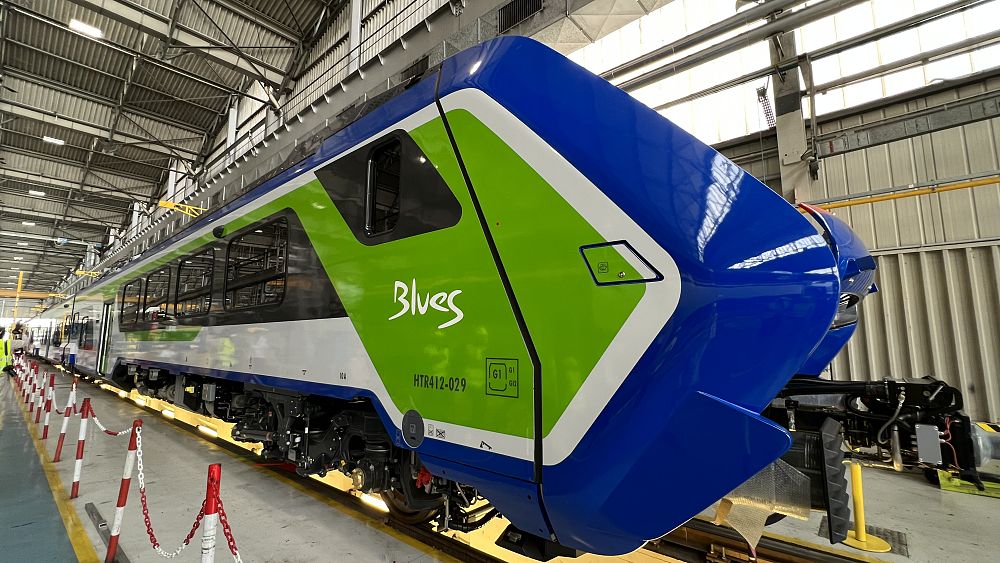
Euronews Green got an inside look around Hitachi’s pioneering train factory in Pistoia, Italy.
But even if 1,000 people taking a train instead of driving 1,000 cars is better for the environment, a diesel engine is never good for the planet – no matter what it’s powering.
Recent investment infrastructure investment might have you thinking: “Aren’t our railways electrified? We don’t need to use diesel trains anymore.”
But in actual fact, only around 60 per cent of Europe’s lines have been updated so far.
“In Italy, for instance, this value is approximately 70 per cent, in some areas like Germany and France, we’re at around 50 per cent,” explains CEO of Hitachi Rail Italy, Luca D’Aquila.
“But there is a great job to do in the UK where the number of electrification is approximately 38 per cent.”
In Italy alone, that equates to around 4,000km of unelectrified track. To upgrade all of the railways in Europe could take decades and the cost would be enormous. Some small regional lines are unlikely to ever see that sort of investment.
To help reduce emissions using Europe’s limited infrastructure, Hitachi Rail has developed its Masaccio tri-brid train. Euronews Green went to their factory in Pistoia, Italy to learn more.
What is a tri-brid train?
Hitachi’s Masaccio is a passenger train that has just been introduced into service in Italy. It’s the kind of train many people use to commute into towns and cities every day.
It can be powered in three ways: via overhead electric lines, via a diesel hybrid engine or via battery.
The revolutionary battery can be charged when the train is running on electricity from the overhead lines. It can also harness the braking energy from the train stopping to charge it too.
“All the energy during braking is [usually] wasted in the brake resistors, so it’s transformed into heat. This is a waste,” Marco Sacchi, Head of Mainline Design Organization tells Euronews Green.
“While with this train, we can transfer it into the battery and reuse it later for accelerating the train.”
How energy efficient is a tri-brid train?
The Masaccio’s onboard battery comes in useful in two different scenarios. The first is to fully power the train, without the need for diesel, for short sections of line where there are gaps in the electrification.
The second is for the approach and departure from a station. By using battery mode, the train doesn’t contribute to a town’s noise or air pollution.
Plus, with the added boost of battery power, the Masaccio can accelerate much faster than previous trains, meaning journey times are getting quicker.
According to CEO Luca D’Aquila, since its introduction in Italy, they’ve seen a 50 per cent reduction in emissions.
Is a tri-brid train really better for the planet?
As with electric cars, we know nothing is a perfect solution. But Hitachi seems to have learnt from some of the mistakes of the automobile world.
Electric cars are usually heavier meaning their tyres wear quicker and there’s a greater stress put on road infrastructure.
Hitachi’s Masaccio is built with ultra-light-weight metals. This means all the strength and safety are still there but, with the added weight of the batteries, they’re no heavier than a regular train.
Hitachi has also teamed up with other parts of its wider brand family to reuse and redistribute materials across their products – particularly critical minerals such as lithium.
What’s next for Hitachi’s eco-trains?
Luca told Euronews Green that the main goal is to eventually reach full climate neutrality. To achieve that, they’re already working on a entirely battery-powered train which they hope to have in service by 2030.
In both the production of the tri-brid and the future battery train, Hitachi plans to retrofit many of their old models to reduce material consumption.
“In addition to this, we are going to start the use of solar panels in our trains [..] to recover most of our needs,” Luca explains.
“Our estimation is that approximately 70 per cent of our needs of energy can be satisfied with solar panels. That means a reduction of approximately 7,000 tonnes of CO2 per year.”
Looking to the future of climate change, the company also tests all of its trains in a specially built climate chamber. Simulating temperatures from -50C to +40, it is hoping to ensure that as the world changes, Hitachi’s trains still run and passengers remain comfortable.
Watch the video above to see the Masaccio in construction in the factory.